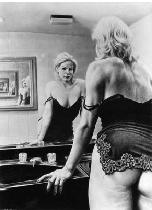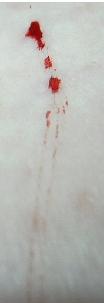Yes. I guess that begs the question, over and over, of who we create art for. Even if you take a beautiful photograph with no one else in mind, you might still want to show it to others, to gage their reaction to it, to share your excitement. Therefore... self-portraiture - is it for both the artist and the audience? Why would anyone want to see a picture of another person, taken by themselves, in what could be deemed a narcissistic (and onanistic, as someone pointed out to me) way? But we do. I love seeing others' self-portraits. But I can't directly say why. They obviously appeal to me on a personal level. Sometimes I like the technique, sometimes I like the use of props etc. Sometimes it's just... I don't know... seeing the way the photographer sees themself. A close up picture of an old man's face would get a different reaction depending on whether the subject is an anonymous person, or the photographer himself.
And then you said - from that vantage point, I felt there might be a pleasing image there somewhere. I began to think about myself as a subject...
So, would the image of yourself have to be pleasing to you in order for you to post it/make it available to an audience? See, this is the other thing, I only put pics on xanga that I am happy with, photoshopped or not, and for this I feel kind of guilty. Like, with my probs re. my self-image, what I would really like to do is be able to post the pics that show my cellulite and round belly. Like that mirrer drawing. I totally love that pic. And I love the shape of women like that. I just wish I felt strong enough to post said pictures and in doing so perhaps
You said - when we introduce the viewer, things change, at least in my opinion.
make other women feel better about themselves. But the media pics of 'attractive' women are everywhere so I can just imagine a lot of young woman shuddering at pics like that and thinking them gross. I know the women I work with hate underarm hair on women etc, so that makes me feel a little uncomfortable, even as I like the way it looks myself.
I think, where men are concerned, it has become a lot more difficult recently. Especially for adolescents, now that footballers are celebrities... I mean, Beckham for instance has been in numerous adverts. There are more male models splashed over the pages, looking very feminine sometimes, which means they are spending a long time preening themselves, checking their weight etc like your friend. There are also more magazines for men, with men's fashion in as well as pics of chicks. The thing is, I would never be attracted to a man who worried to that extent about the way he looked. I wouldn't want my man to wax his chest or something else as ridiculous.


to continue…
I found what you said about your self-portraits really interesting, mostly because it would never have occurred to me that you were anything but unhappy about your body. (On a side note, I recently read the abstract of a journal that equated BDD [body dsymorphic disorder] with creative people. It suggested that artists etc scrutinise to the point of obsession sometimes, and are perfectionists. Often this goes beyond their art to their own self image.)
It seems to me that there are 2 types of self-portrait. One is what we do - looking at the body as it is, for any number of reasons - the living body, that which is very personal, body plus mental image. A lot of it is a psychoanalytical reaction. And then there is the other type - used by such artists as Orlan, Cindy Sherman and Claude Cahoon, where the body is manipulated, deformed, morphed into characters. For Orlan it would seem that rather than creating somebody different, she is remaining Orlan, but differentiating her idea of 'self' from her physical body. She has had numerous operations on her face, had lumps inserted beneath the skin on her forehead, has said she wanted the nose from one famous painting, the chin from another etc http://www.english.ucsb.edu/faculty/ecook/courses/eng114em/whoisorlan.htm Her operations are filmed, and she remains conscious and active (as opposed to passive) throughout, talking to the film crew, the surgeons, and answering questions that are
faxed in. It's about the process of change versus stasis (I think). Sherman and Cahoon, on the other hand, use themselves as models to create 'film stills' or portraits. Like interruptions. The girl lying on the floor with the crumpled piece of paper in her hand. The woman folding her arms around herself and looking into the distance etc etc.
The Subject of Object continued...
